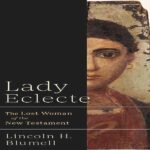- عنوان رمان: Lady Eclecte The Lost Woman of the New Testament
- نویسنده: Lincoln H. Blumell
- سال انتشار: 2025
- تعداد صفحه: 315
- زبان اصلی: انگلیسی
- نوع فایل: pdf
- حجم فایل: 5.56 مگابایت
اولین پاپیروسی که من ویرایش و منتشر کردم، یک دادخواست یونانی از اکسیریانکوس بود که تاریخی معادل ۱۷ مارس ۲۹۱ میلادی داشت. این دادخواست به «رئیس پلیس» شهر ارائه شد و توسط زنی به نام اورلیا هرمانوبیانا ثبت شده بود. در این دادخواست، او گزارش میدهد که شوهرش، سیریل، شش هفته قبل به همراه ملوانی به نام ایسچیریون برای انجام کاری رفته بود. او ادعا میکند که از آن زمان، هیچ خبری از شوهرش نداشته و روزی که دادخواست را ارائه داده، ایسچیریون را در شهر در حالی که لباسهای شوهرش را پوشیده بود، یافته است! او از ترس اینکه بدترین اتفاق ممکن به دست ملوان برای سیریل رخ داده باشد، ایسچیریون را به سرعت بازداشت کرد و خواستار اجرای عدالت شد. در این مرحله، دادخواست ناگهان پایان یافت. اینکه چه اتفاقی برای سیریل افتاد، شاید هرگز نفهمیم. کار بر روی این پاپیروس هم به طرز دردناکی ناامیدکننده و هم فوقالعاده هیجانانگیز بود. رمزگشایی متن نه تنها به دلیل وضعیت مبهم پاپیروس ۱۷۰۰ ساله، بلکه به دلیل وجود خطاهای املایی و دستوری مختلف که در ابتدا تفسیر صحیح را مختل میکرد، پیچیده بود. با وجود این چالشها، کنار هم قرار دادن هر سطر متوالی داستان با پیشرفت طرح داستان، هیجانانگیز بود. از زمان انتشار آن پاپیروس، متون بسیاری دیگر را ویرایش کردهام، از رسیدهای مالیاتی، نسخههای پزشکی، برچسبهای مومیایی، فهرست نامها و اجارهنامهها گرفته تا طلسمها، طلسمهای عشق، سخنرانیهای کلاسی و قطعات کتاب مقدس. من همچنین روی چندین نامه باستانی کار کردهام، یا قطعات منتشر نشده قبلی را ویرایش کردهام یا قطعاتی را که قبلاً منتشر شده بودند، دوباره ویرایش کردهام و بینش جدیدی را که در نسخههای قبلی وجود نداشت، اضافه کردهام. من نامههایی را که از دوره بطلمیوسی تا دوره بیزانس (حدود ۳۲۳ پیش از میلاد تا ۶۴۲ میلادی) روی پاپیروس حفظ شدهاند، ویرایش کردهام. نامهها از جمله متون مورد علاقه من برای ویرایش هستند. آنها در جاهایی بسیار کلیشهای هستند، اما در جاهای دیگر نیز به طرز فوقالعادهای متنوع هستند، زیرا هر نامه داستان خاص خود را دارد. فکر میکنم یکی از دلایلی که به ویژه به نامههای باستانی جذب میشوم این است که آنها اغلب بر افراد تمرکز دارند و چیزی در مورد زندگی روزمره و روابط بین فردی آنها آشکار میکنند. پس از خواندن نامه کسی، من آنها را به طور خلاصه میشناسم. این تکنگاری، که در درجه اول به آدرس موجود در دوم یوحنا ۱ میپردازد، مستقیماً از کار من در پاپیروسشناسی الهام گرفته شده است. از بسیاری جهات، دوم یوحنا شباهتهایی با پاپیروسهای مختلف نامهنگاری دارد که من در طول سالها ویرایش کردهام. این نباید تعجبآور باشد زیرا یونانی اصلی دوم یوحنا ۱۲ بیان میکند که نامه روی χάρτης (پاپیروس) نوشته شده است. به این ترتیب، این تنها نامه در کل عهد جدید است که به صراحت رسانهای را که با آن نوشته شده است بیان میکند. در حالی که به طور سنتی تصور میشود که این نامه حاوی یک خطاب استعاری به کلیسایی است که به عنوان “بانوی برگزیده” شخصیتپردازی شده است، با استفاده از بینشهایی که من در ویرایش و ویرایش مجدد نامههای باستانی ایجاد و اصلاح کردهام، نشان خواهم داد که تفسیر غالب از خطاب در نامه نادرست است. در عوض، این نامه خطاب به زنی با نام یونانی اکلکته (Ἐκλέκτη) نوشته شده است. اگرچه او به دلیل حذف دو حرف تکراری نزدیک به دو هزار سال گم شده است، اما وقتی آدرس صحیح به دوم یوحنا ۱ بازگردانده میشود، به طرز چشمگیری دوباره ظاهر میشود. همانطور که من سعی کردهام زندگی مردان و زنان باستانی را که در اسنادی که از خود به جا گذاشتهاند، روشن کنم، امیدوارم که به درستی بانوی اکلکته از دوم یوحنا را نیز روشن کنم.
The first papyrus I edited and published was a Greek petition from Oxyrhynchus that carried a date corresponding to March 17, 291 CE. It was submitted to the “police chief” of the city and was filed by a woman named Aurelia Hermanoubiaina. In the petition, she reports that her husband, Cyril, had left on business six weeks earlier in the company of a sailor named Ischyrion. She alleges that since then, she had heard nothing from her husband and that on the day she submitted the petition, she found Ischyrion back in the city wearing her husband’s clothes! Fearing that the worst had befallen Cyril at the hands of the sailor, she had Ischyrion swiftly detained and was demanding that justice be exacted. At this point, the petition abruptly ended. What happened to Cyril, we may never know. Working on this papyrus was both painfully frustrating and incredibly exciting. Decipherment of the text was complicated not only by the lacunose condition of the 1,700-year-old papyrus but also because it contained various orthographical and grammatical errors that initially frustrated the correct interpretation. Despite these challenges, piecing together each successive line of the story was exhilarating as the plot developed. Since publishing that papyrus, I have edited many other texts, from tax receipts, medical prescriptions, mummy labels, name lists, and leases to amulets, love spells, classroom lectures, and biblical fragments. I have also worked on several ancient letters, either editing previously unpublished pieces or reediting pieces previously published and adding some new insight that was lacking in an earlier edition. I have edited letters preserved on papyrus from the Ptolemaic period through the Byzantine period (ca. 323 BCE–642 CE). Letters are among my favorite texts to edit. They are highly formulaic in places but also exceptionally diverse in other places as each letter contains its own story. I think one of the reasons I am particularly drawn to ancient letters is that they often focus on people and reveal something about their daily lives and interpersonal relations. After reading someone’s letter, I get to know them in a small sense. This monograph, which primarily deals with the address in 2 John 1, is directly informed by my work in papyrology. On many fronts, 2 John shares similarities with the various epistolary papyri I have edited over the years. This should not be surprising as the underlying Greek of 2 John 12 states that the letter was written on χάρτης (papyrus). As such, it is the only letter in the entire New Testament canon that explicitly states the medium on which it was written. While this letter is traditionally thought to contain a metaphorical address to a church personified as an “elect lady,” using the insights I have developed and honed editing and reediting ancient letters, I will demonstrate that the prevailing interpretation of the address in the letter is incorrect. Instead, the letter is addressed to a woman bearing the Greek name Eclecte (Ἐκλέκτη). Though she has been lost for nearly two millennia due to the omission of two reduplicated letters, she dramatically reemerges when the correct address is restored to 2 John 1. Just as I have sought to bring to light the lives of ancient men and women who reside in the documents they have left behind, I hope to properly bring to light Lady Eclecte of 2 John.
این رمان را میتوانید از لینک زیر بصورت رایگان دانلود کنید:



































نظرات کاربران